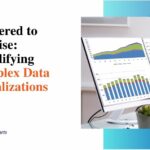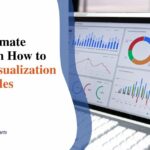VR AR Data Visualization: What You Need to Know
The world of data visualization is going to new heights. Because the Web browsers allow access to a client’s GPU, It has become more budget-friendly platforms of data. Storytelling is expanding into the virtual world.The ‘VR AR data visualization‘ was already a strong consideration during the COVID times. However the need for a virtual and collaborative environment is rising with teams who are working remotely.
You may deliver a winning communication tactic with VR and AR presentations in an interactive and simple 3D experience. The demand for AR and VR in data visualization keeps growing across various industries. In this blog, we will look at exactly how creative charts and graphs, along with other data visualization elements, are transforming with VR and AR.
Data insights that are enhanced and actionable
In an average company collecting, analyzing and extracting useful insights takes a lot of time. And it creates bloody and irrelevant conclusions. This is the place where data visualizations play a Key role. They extract and inspect only the data that is actionable with little effort. The use of ar and vr in data visualization enhances the effectiveness.
For example, integrating VR techniques in the product development lifecycle can accurately detect the errors and flaws that may further lead to procedure hampering or other business difficulties.
VR AR in data visualization with lesser distractions

The VR AR data visualization transforms boring and plain numbers into catchy stories to understand the data better. Users may directly engage with the big data that surrounds them and explore it with their hands instead of keyboards and mice. The engagement through virtual reality is further natural as you press buttons, zoom in on graphs, and arrange the data streams.
The artistic data visuals require a lot of attention. Applications that are VR-enabled grant a better user experience to engage with the data and make data visualization more creative and effective. Integrating AR into AR glasses or contact lenses may decrease intrusions and provide a hand-free engagement experience.
Visualizing the data structures in VR and AR helps you concentrate better on the objectives as you will have an entire field vision. It grants a genuine feel of scale and a holistic vantage as you are immersed in the data that is impossible with conventional data visualization.
Better capabilities in decision-making
Implementing VR and AR solutions significantly increase the decision-making of any company. The data scientists can leverage these advantages of collecting essential facts and figures. These are collected from the analysis report with the assistant of data visualization. Other than data visualization of the organization, using VR or AR helps in creating strategies that are effective. These strategies are effective in attaining critical business milestones in no time. It facilitates the processes of business by enabling prompt responses. These responses run daily operation effectively.
Real-time collaboration
A collaborative form of massive data visualization presents the data on the table and allows the users to hover over it, generate charts, and explore the details. Users may go ahead and also add new graphs, variables, and datasets and understand the data through variable immersive technologies. The visualization may also work as a virtual room for meetings where the whole team may collaborate and work on the data projections. For instance, Virtualitics, one of many tech leaders in the space, grants 3D data sets that different users may experience and manipulate simultaneously.
Improved data presentations
Opposite of 2D data representations, the 3D visualizations use immersive technologies. These technologies are very effective at increasing the processes of data research during different stages. These days data scientists are largely using challenges to investigate complicated data structures. They are doing it to extract hidden patterns via immersive technology. The real simulations emphasize the process of Data explorations. Also, it predicts business outcomes through the 3D models.
Wrapping Up
Data drawings & illustrations are indeed part of data visualization. While conventional ways have certain limitations, the implementation of VR and AR makes them much more accessible. Even in the business ecosystem, accurate data analysis is the key to today’s data. The concept of VR AR data visualization boils down to the complexity of the data and offers more natural interactions.
It will also allow the companies to enhance their growth curve through advanced data visualization and analytics. With Storytelling With Charts, you will be in a better position to understand the applications of VR AR in data visualization.
FAQs
1. What is an unknown advantage of VR in data visualization?
When data is presented in VR, more than one user has access to it at the same time.
2. Why use AR and VR in data visualization?
By utilizing VR and AR, you will have more hands-on experience with visualizations. It is something that makes it easy for the users.
3. Why should companies use AR?
Companies should implement AR in data visualization so that users may have more hands-on experience.







